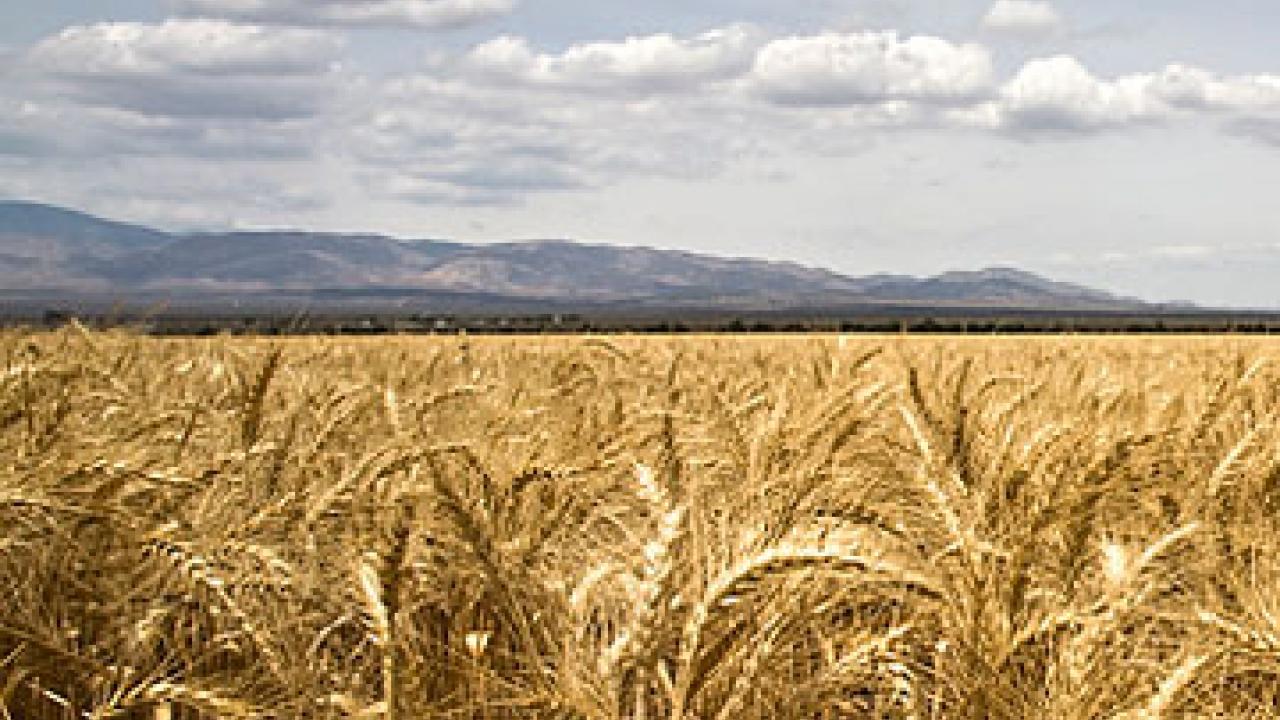Rising levels of atmospheric carbon dioxide interfere with plants’ ability to convert nitrate into protein and could threaten food quality, according to a new study by researchers at the University of California, Davis. The scientists suggest that, as global climate change intensifies, it will be critical for farmers to carefully manage nitrogen fertilization in order to prevent losses in crop productivity and quality.
The study, which examined the impact of increased carbon dioxide levels on wheat and the mustard plant Arabidopsis, will be published in the May 14 issue of the journal Science.
"Our findings suggest that scientists cannot examine the response of crops to global climate change simply in terms of rising carbon dioxide levels or higher temperatures,” said lead author Arnold Bloom, a professor in UC Davis’ Department of Plant Sciences.
“Instead, we must consider shifts in plant nitrogen use that will alter food quality and even pest control, as lower protein levels in plants will force both people and pests to consume more plant material to meet their nutritional requirements," Bloom said.
Climate change, CO2 and agriculture
Historical records have documented that the concentration of carbon dioxide in Earth’s atmosphere has increased by 39 percent since 1800. If current projections hold true, the concentration will increase by an additional 40 to 140 percent by the end of the century.
This trend is of concern to agriculture because elevated atmospheric carbon dioxide levels have been shown to decrease the rates of photorespiration, the naturally occurring chemical process that combines oxygen with carbohydrates in plants.
At first, this reduction in photorespiration boosts photosynthesis, the complementary process by which plants grow by using sunlight to turn water and carbohydrates into chemical energy in the form of plant sugars. In time, however, the increase in the rate of photosynthesis tapers off as the plants adjust to increased atmospheric carbon dioxide, and plant growth slows.
The nitrogen connection
Nitrogen is the mineral element that plants and other living organisms require in the greatest quantity to survive and grow. Plants obtain most of their nitrogen from the soil and, in the moderate climates of the United States, absorb most of it through their roots in the form of nitrate. In plant tissues, those compounds are assimilated into organic nitrogen compounds, which have a major influence on the plant’s growth and productivity.
Earlier research has shown that when atmospheric carbon dioxide concentrations increase by 50 percent, the nitrogen status of plants declines significantly.
More specifically, findings from previous research by Bloom and colleagues suggested that elevated levels of carbon dioxide decreased photorespiration and inhibited nitrate assimilation in plant shoots.
New UC Davis study
In their most recent study, Bloom’s team examined the influence of elevated carbon dioxide levels and, in some cases, low atmospheric oxygen concentrations, on nitrate assimilation in wheat and Arabidopsis plants using five different methods.
Data from all five methods confirm that elevated levels of carbon dioxide inhibit nitrate assimilation in wheat and Arabidopsis plants. The researchers note that this effect could explain why earlier studies by other researchers have documented a 7.4-percent to 11-percent decrease in wheat grain protein and a 20-percent decrease in total Arabidopsis protein under elevated carbon dioxide levels.
“This indicates that as atmospheric carbon dioxide concentrations rise and nitrate assimilation in plant tissues diminishes, crops will become depleted in organic nitrogen compounds, including protein, and food quality will suffer,” Bloom said. “Increasing nitrogen fertilization might compensate for slower nitrate assimilation rates, but this might not be economically or environmentally feasible.”
He noted that farmers might be able to increase their use of nitrogen-rich ammonium fertilizers to ease the bottleneck of nitrate assimilation in crops but would have to carefully manage fertilizer applications to avoid toxic accumulations of ammonium in the plants.
To develop solutions for dealing with the impact of major increases in atmospheric carbon dioxide levels on crops, further research is needed on how plants assimilate nitrate and ammonium, Bloom said.
Working with Bloom on this study were Martin Burger of UC Davis’ Department of Land, Air and Water Resource; Jose Salvador Rubio Asensio of UC Davis’ Department of Plant Sciences; and Asaph B. Cousins, currently of the School of Biological Sciences at Washington State University.
Funding for this study was provided by the National Science Foundation, the U.S. Department of Agriculture and Spain’s Agencia Regional de Ciencia y Tecnologia.
About UC Davis
For more than 100 years, UC Davis has engaged in teaching, research and public service that matter to California and transform the world. Located close to the state capital, UC Davis has 32,000 students, an annual research budget that exceeds $600 million, a comprehensive health system and 13 specialized research centers. The university offers interdisciplinary graduate study and more than 100 undergraduate majors in four colleges — Agricultural and Environmental Sciences, Biological Sciences, Engineering, and Letters and Science. It also houses six professional schools — Education, Law, Management, Medicine, Veterinary Medicine and the Betty Irene Moore School of Nursing.
Media Resources
Pat Bailey, Research news (emphasis: agricultural and nutritional sciences, and veterinary medicine), 530-219-9640, pjbailey@ucdavis.edu
Arnold Bloom, Plant Sciences, (530) 752-1743, ajbloom@ucdavis.edu
